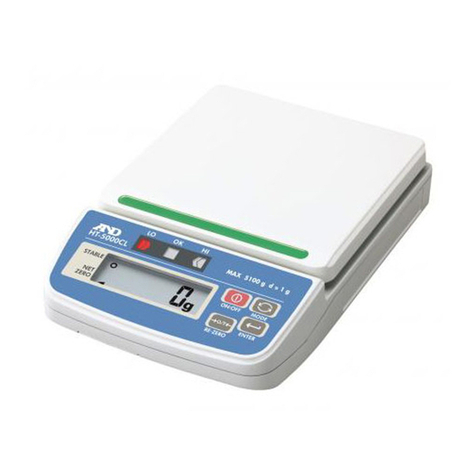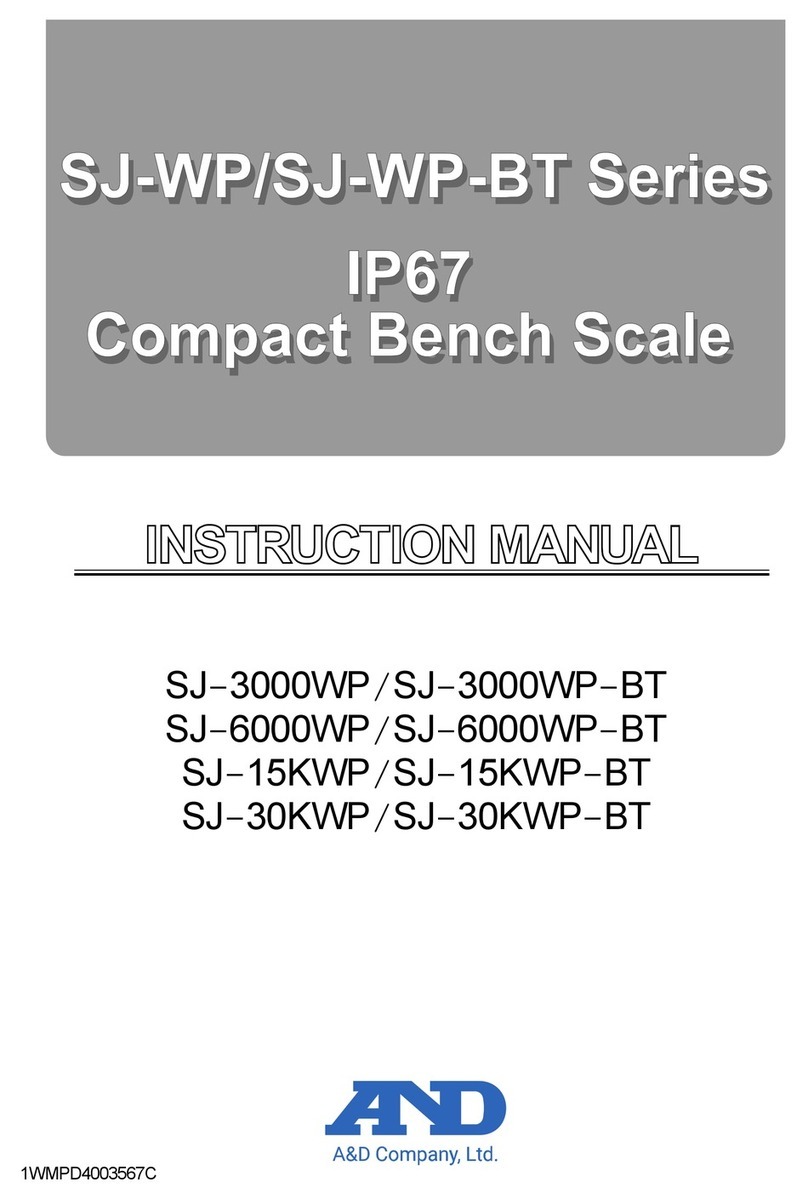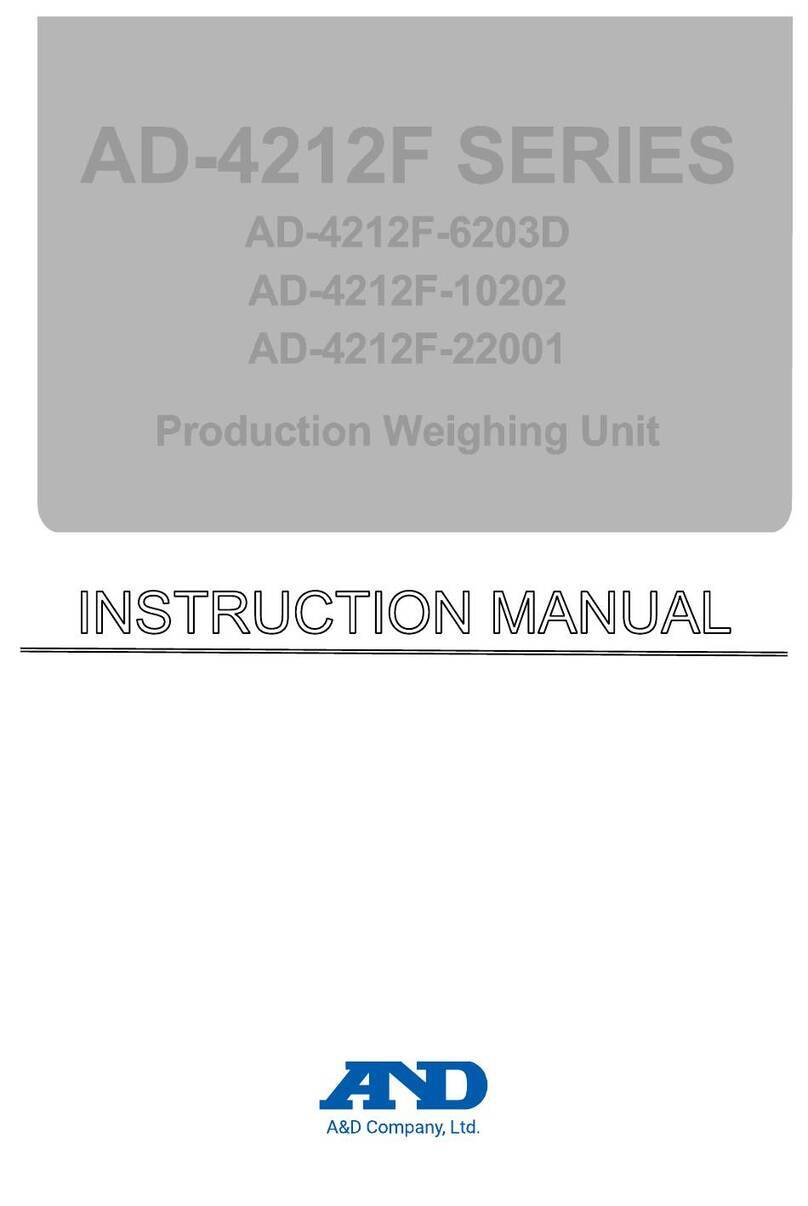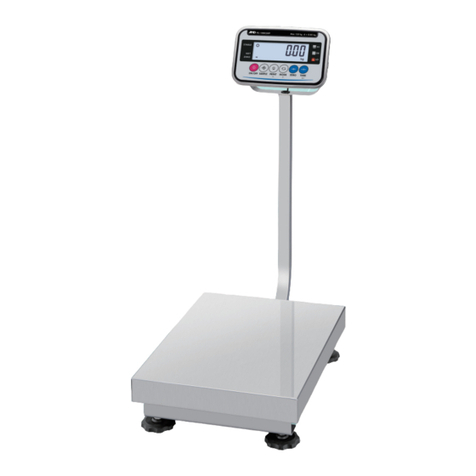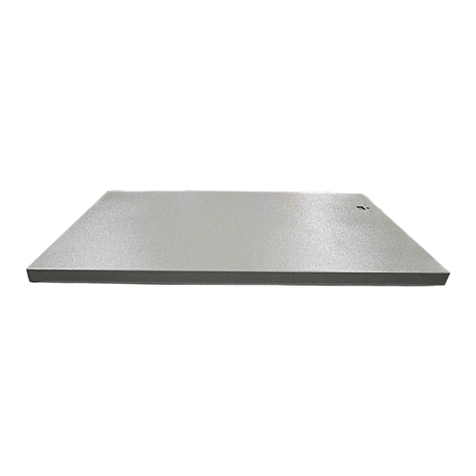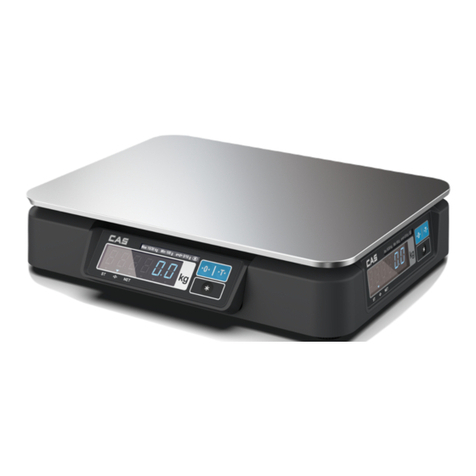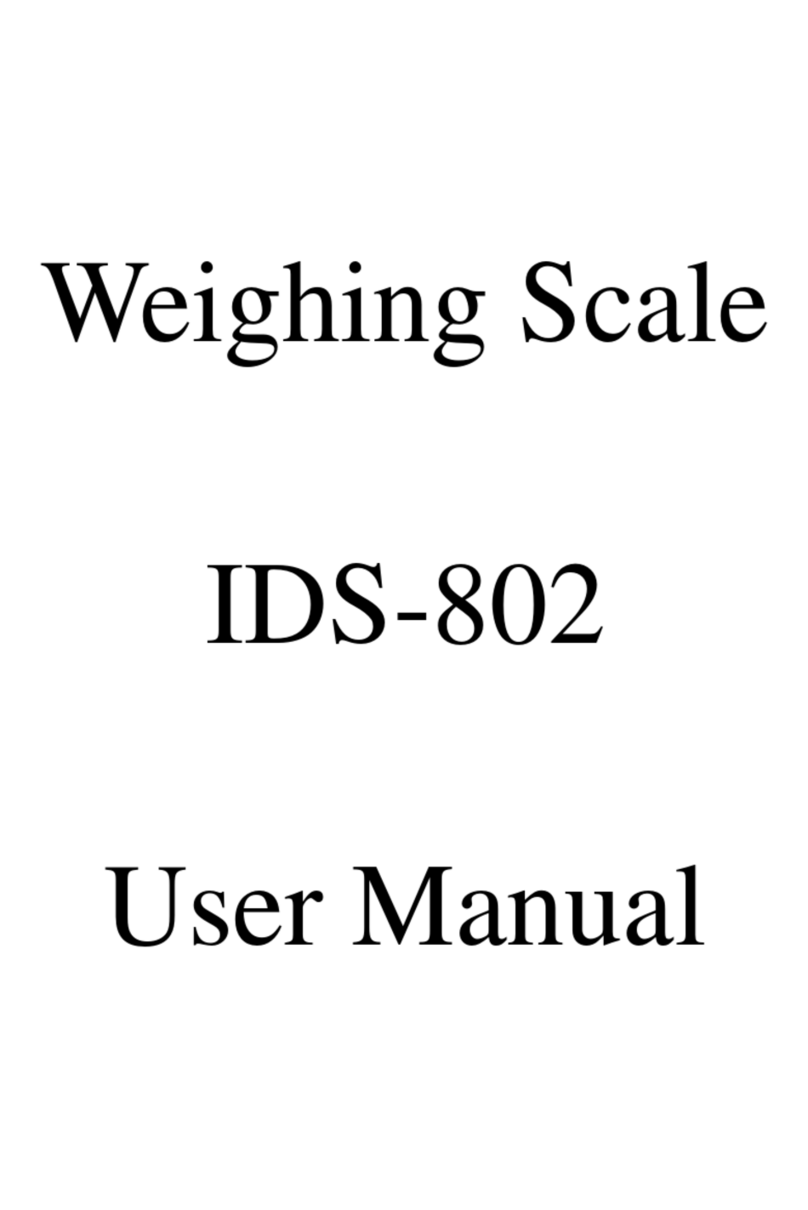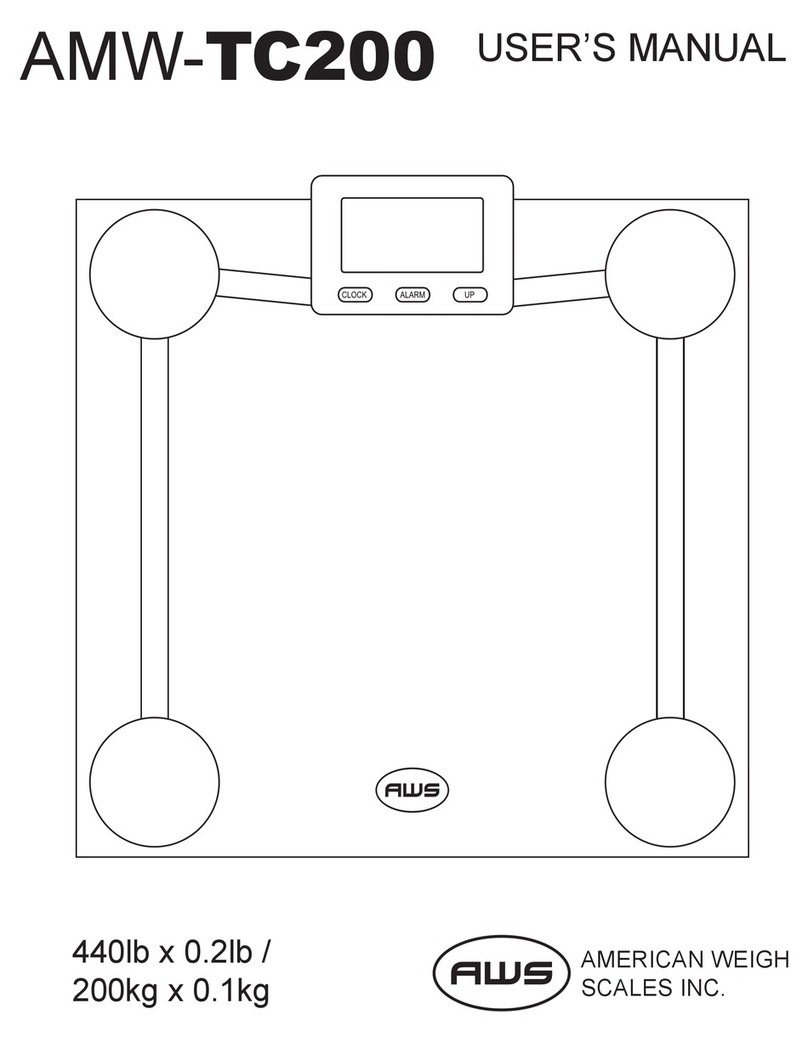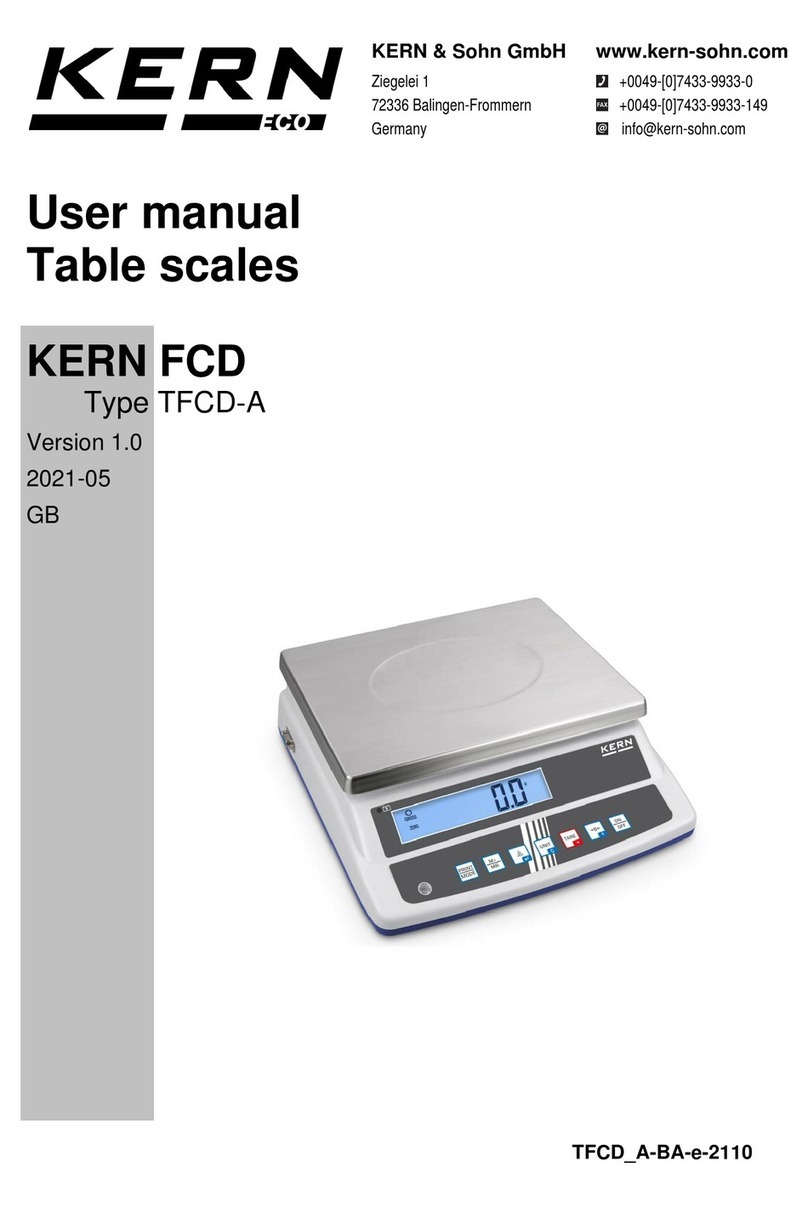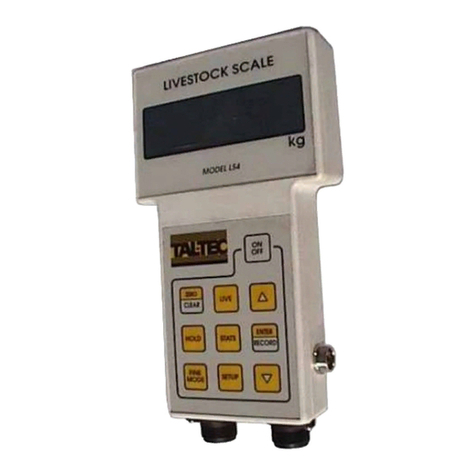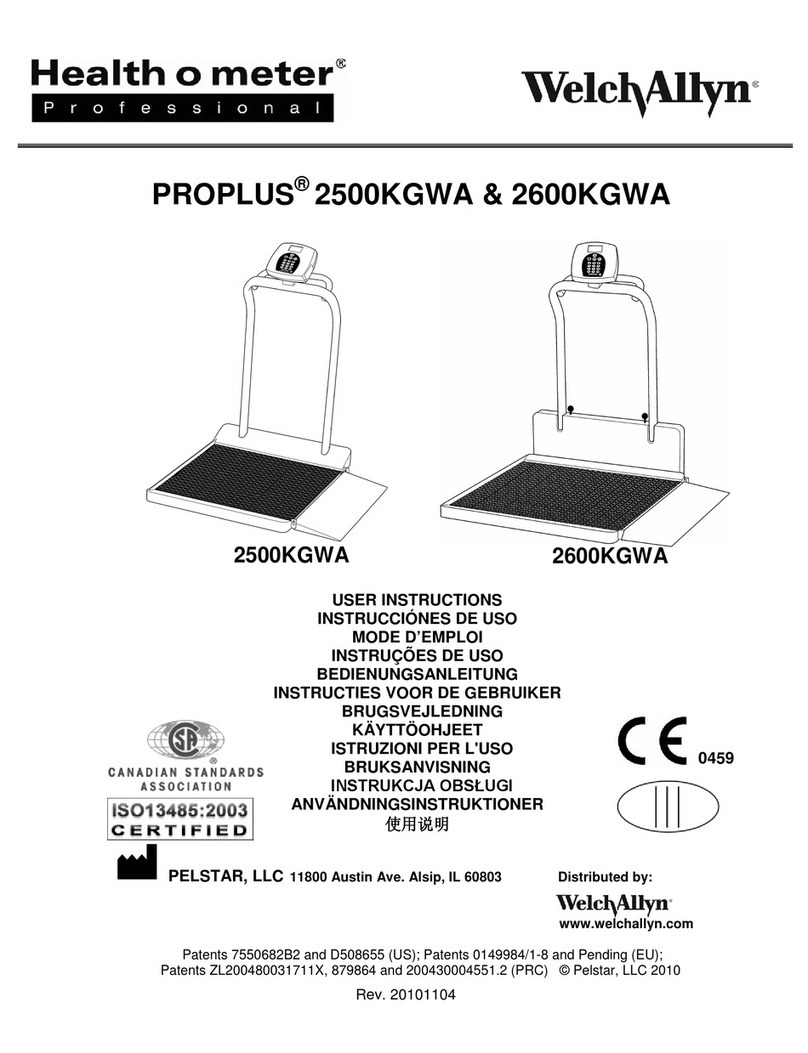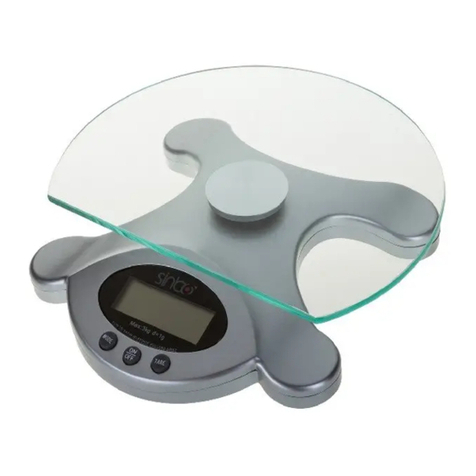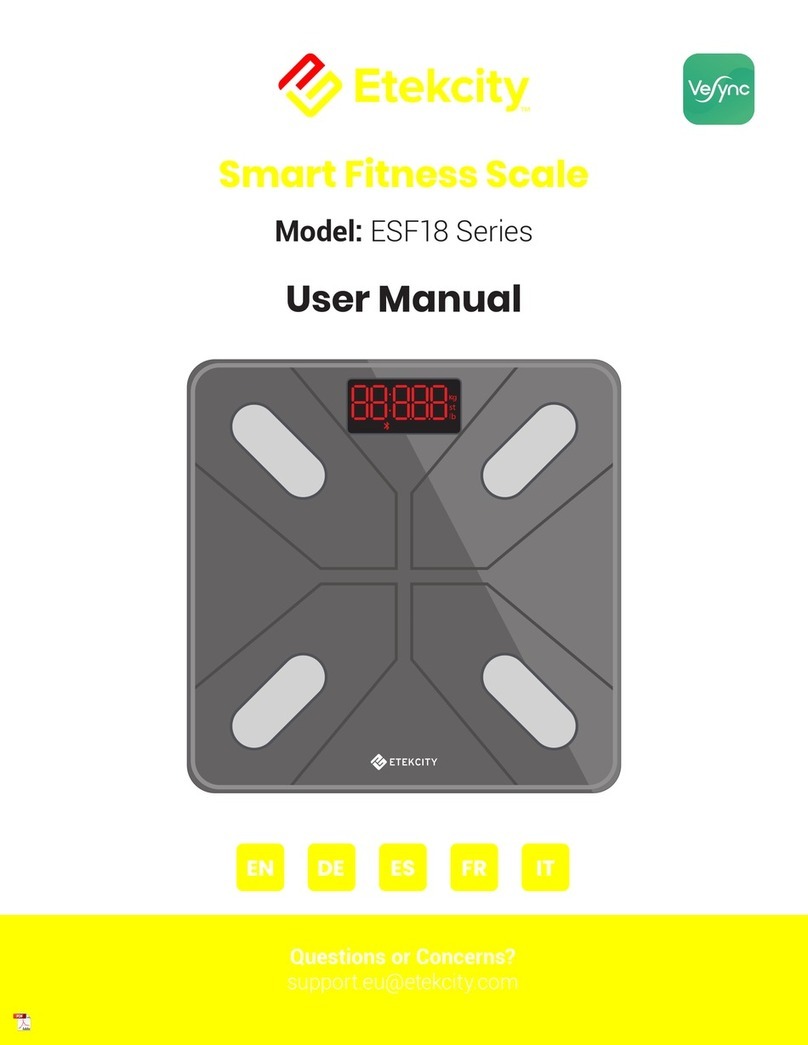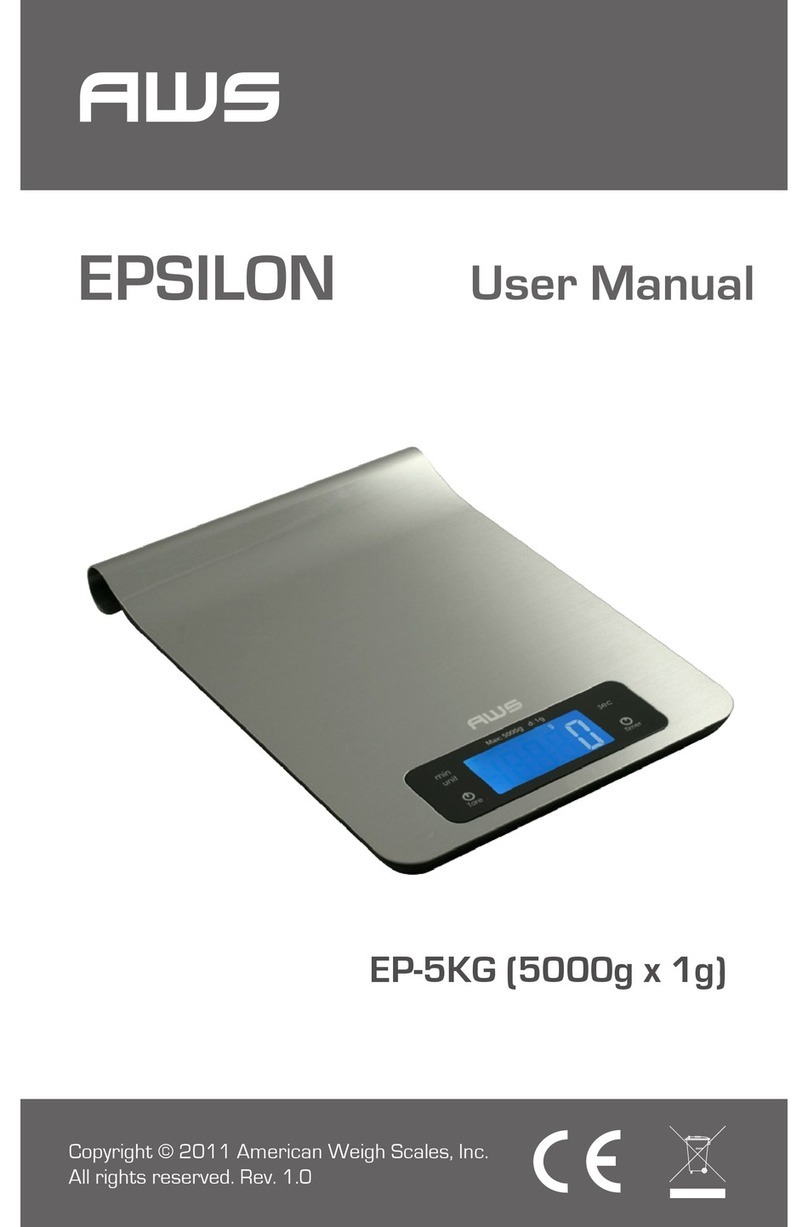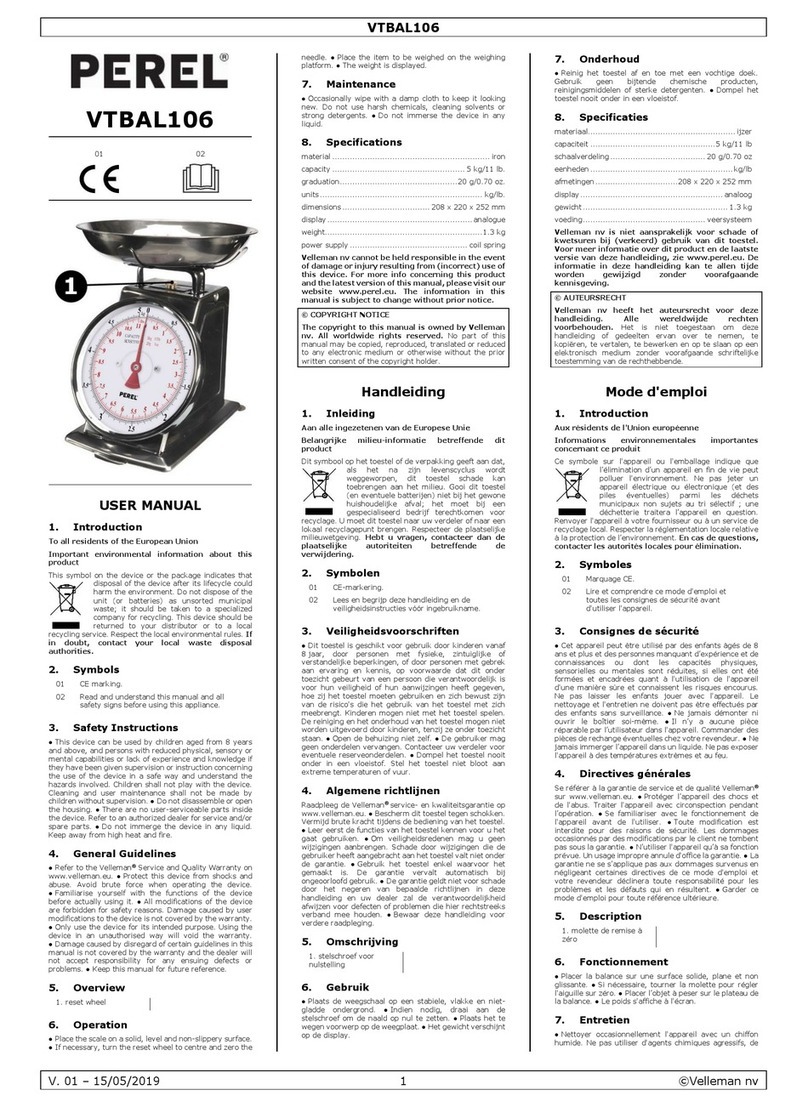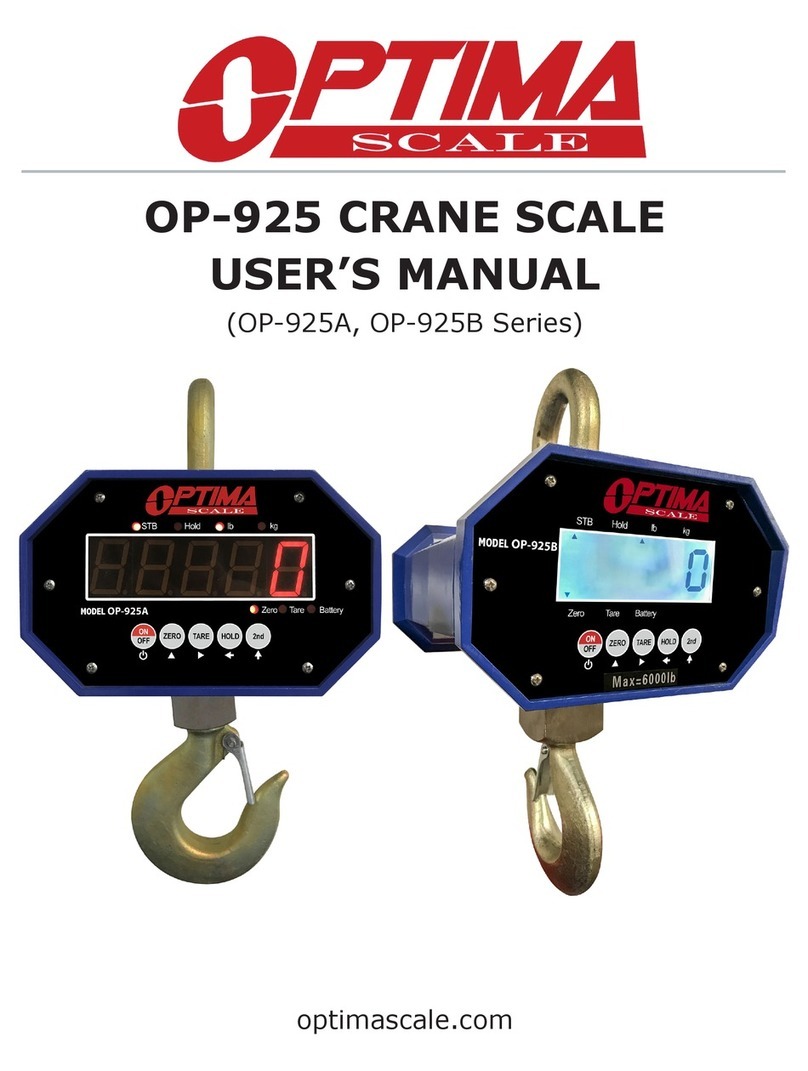AND GX-M Series User manual

INSTRUCTION MANUAL
G
GG
X
XX
-
--
M
MM
S
SS
E
EE
R
RR
I
II
E
EE
S
SS
G
G
G
F
F
F
-
-
-
M
M
M
S
S
S
E
E
E
R
R
R
I
I
I
E
E
E
S
S
S
M
M
M
u
u
u
l
l
l
t
t
t
i
i
i
-
-
-
F
F
F
u
u
u
n
n
n
c
c
c
t
t
t
i
i
i
o
o
o
n
n
n
B
B
B
a
a
a
l
l
l
a
a
a
n
n
n
c
c
c
e
e
e
1WMPD4003846
GX-Mseries
GX-8202M / GX-8202MD / GX-10202M / GX-12001M
GX-22001M /GX-32001M / GX-32001MD
GF-M series
GF-8202M / GF-8202MD / GF-10202M / GF-12001M
GF-22001M / GF-32001M / GF-32001MD

© 2020 A&D Company Ltd. All rights reserved.
No part of this publication may be reproduced, transmitted, transcribed, or translated
into any language in any form by any means without the written permission of A&D
Company Ltd.
The contents of this manual and the specifications of the instrument covered by this
manual are subject to change for improvement without notice.
Windows, Word and Excel are registered trademarks of the Microsoft Corporation.

3
Contents
1. Introduction.................................................................................................................... 6
1-1 Features ................................................................................................................................................. 6
1-2 About The Models .................................................................................................................................. 7
1-3 Compliance ............................................................................................................................................ 7
1-4 About Communication Manual ............................................................................................................... 8
2. Unpacking The Balance................................................................................................. 9
2-1 Installing The Balance.......................................................................................................................... 10
3. Precautions...................................................................................................................11
3-1 Before Use.............................................................................................................................................11
3-2 During Use............................................................................................................................................ 12
3-3 After Use............................................................................................................................................... 12
3-4 Power Supply ....................................................................................................................................... 13
4. Display Symbols And Key Operation ........................................................................... 14
4-1 Smart Range Function ......................................................................................................................... 16
5. Weighing Units............................................................................................................. 17
5-1 Units ..................................................................................................................................................... 17
5-2 Storing Units......................................................................................................................................... 22
6. Weighing...................................................................................................................... 24
6-1 Basic Operation.................................................................................................................................... 24
6-2 Counting Mode(PCS)...................................................................................................................... 26
6-3 Percent Mode (%)................................................................................................................................ 28
6-4 Animal Weighing Mode(Hold Function)........................................................................................... 29
7. Impact Detection Function ........................................................................................... 30
7-1 Recording Impact History..................................................................................................................... 31
7-2 Output Impact History........................................................................................................................... 31
8. Response Adjustment / Self Check Function............................................................. 33
8-1 Response Adjustment .......................................................................................................................... 33
8-2 Self-Check-Function / Automatic Setting Of Minimum Weight Value................................................... 34
9. Calibration.................................................................................................................... 36
9-1Automatic Self Calibration For The GX-M Series................................................................................... 37
9-2 One-Touch Calibration For The GX-M Series...................................................................................... 38
9-3 Calibration Using An External Weight .................................................................................................. 39
9-4 Calibration Test Using An External Weight........................................................................................... 40
9-5 How to set the External Weight Value.................................................................................................. 41
9-6 Correcting The Internal Mass Value Of The GX-M series.................................................................... 42
9-7 Correcting The Internal Mass Value Of The GX-M series (Auto).............................................................. 43
10. Function Switch And Initialization............................................................................... 44
10-1 Permit Or Inhibit ................................................................................................................................. 44

4
10-2 Initializing The Balance....................................................................................................................... 46
11. Function Table ............................................................................................................47
11-1 Setting The Function Table.................................................................................................................47
11-2 Details Of The Function Table ............................................................................................................49
11-3 Description Of The Class "Environment, Display"..............................................................................56
11-4 Description Of The Data Output .........................................................................................................57
11-5 Description Of The Data Format.........................................................................................................57
11-6 Output Example Of The Data Format.................................................................................................57
11-7 Clock And Calendar Function.............................................................................................................58
11-8 Comparator Function.......................................................................................................................... 60
11-9 Adding the Comparison Results .........................................................................................................66
11-10 Main Display Comparison Function.................................................................................................. 67
11-11 Description Of Application.................................................................................................................68
11-12 Outputting the function setting information.......................................................................................69
12. ID Number And GLP Report.......................................................................................72
12-1 Main Objective....................................................................................................................................72
12-2 Setting The ID Number.......................................................................................................................72
12-3 GLP Report.........................................................................................................................................74
13. Data Memory..............................................................................................................78
13-1 Data Memory For Weighing Data.......................................................................................................78
13-2 Data Memory For Calibration And Calibration Test............................................................................82
13-3 Data Memory for Unit Mass in the Counting Mode ............................................................................85
13-4 Data Memory for Comparator Settings...............................................................................................88
13-5 Data Memory for Tare Value...............................................................................................................91
13-6 Data Memory: Quick Selection Mode.................................................................................................94
13-7 Data Memory: Confirmation and Storage Mode.................................................................................95
14. Statistical Calculation Mode........................................................................................97
14-1 How To Use The Statistical Calculation..............................................................................................97
14-2 Statistical Calculation Mode (Example Of Use)................................................................................102
15. Flow Measurement...................................................................................................104
15-1 How To Use Flow Measurement ...................................................................................................... 104
16. Gross Net Tare Function...........................................................................................108
16-1 Preparation Of Gross Net Tare Function..........................................................................................108
16-2 Example Of Using The Gross Net Tare Function............................................................................. 110
17. Minimum Weighing Warning Function...................................................................... 111
17-1 Comparing the minimum weighing value ..........................................................................................111
17-2 Entering and outputting the minimum weighing value...................................................................... 112
18. Underhook................................................................................................................117
19. Programmable-Unit ..................................................................................................118
20. Density Measurement...............................................................................................119

5
21. Password Lock Function.......................................................................................... 124
21-1 Enable Password Lock Function...................................................................................................... 125
21-2 How To Input The Password At The Start Of Weighing.................................................................... 126
21-3 How To Logout.................................................................................................................................. 127
21-4 Registering Password (Changing) ................................................................................................... 128
21-5 Changing Password ......................................................................................................................... 129
21-6 How To Delete The Password(U5ER 01~10)................................................................................. 130
21-7 Missing Password ............................................................................................................................ 130
22. Repeatability Check Function (GX-M series only)................................................. 131
23. Interface Specification(Standard)........................................................................ 132
24. Maintenance ............................................................................................................ 132
24-1 Treatment Of The Balance............................................................................................................... 132
25. Troubleshooting ....................................................................................................... 133
25-1 Checking The Balance Performance And Environment................................................................... 133
25-2 Error Codes...................................................................................................................................... 134
25-3 Other Display.................................................................................................................................... 137
25-4 Asking For Repair............................................................................................................................. 137
26. Connection With Periphecal Device......................................................................... 138
26-1 Command......................................................................................................................................... 138
26-2 Key Lock Function............................................................................................................................ 138
27. How To Check The Software Version Of The Balance............................................. 138
28. Specifications........................................................................................................... 139
29. External Dimention................................................................................................... 141
29-1 Options And Peripheral Instruments ................................................................................................ 142

6
1. Introduction
This manual describes how the GX-M/GF-M series balance works and how to get the most out of it in
terms of performance. Read this manual thoroughly before using the balance and keep it at hand for
future reference.
Depending on the software version of your balance, there are cases that behave differently.
For confirmation of the software version of the balance, refer to "27. How To Check The Software
Version Of The Balance".
1-1 Features
□The balance has a self-check function that inspects the balance itself using electronically
controlled load (ECL) and evaluates performance.Read this manual thoroughly before using the
balance and keep it at hand for future reference.
□The balance can detect impact applied to its mass sensor and display the level of that impact.
ISD (Impact Shock Detection).
□Continuous change of the balance can be calculated as flow rate, displayed and output. FRD :( Flow
Rate Display).
□The balance is equipped with a data memory function, which can record weighing value,
calibration result, and multiple unit mass (mass per sample in counting mode) (Up to 200 items
are stored for weighing value).
□The GX-M series has automatic self calibration using the internal mass, adapting to temperature
changes, setting time and interval time.
□Good laboratory practice (GLP) / Good manufacturing practice (GMP) data can be output using
the RS-232C serial interface.
□A built-in clock and calendar that can add the time and date to the output data.
(Setting changes due to the clock can be limited only for an administrator. (Password Lock
Function))
□Comparator Indicators, displaying the comparison results with HI OK LO .(Depending on
the setting, 5-step comparison is also possible.)
□Capacity Indicator, displaying the weight value in percentage relative to the weighing capacity.
□Hold Function, provided for weighing a moving object such as an animal.
□Underhook, for measuring density and weighing magnetic materials.
□Password lock function can limit users for the balance to be used or changes due to the function
settings by setting a password.
□Key lock function allows the balance to only operate using commands from an external equipment
by disabling key operations on the balance.
□The balance is equipped with an RS-232C serial interface and a USB interface to communicate
with a computer. Windows computer using the Windows communication tools software (WinCT)
make building a system very easy. The latest Win-CT software can be downloaded from the A&D
website.
Windows is the registered trademark of the Microsoft Corporation.
□A breeze break is included with the model featuring a minimum display of 0.01g.

7
1-2 About The Models
There are many models in the GX-M series and GF-M series with differences in the models being the
minimum display and weighing capacity. In this manual, they are listed collectively by the minimum
display as shown in the table below.
Model
Minimum
display
Applicable model
Internal mass type
General type
0.01g model 0.01g
GX-8202M / GX-8202MD
GX-10202M
GF-8202M / GF-8202MD
GF-10202M
0.1g model 0.1g
GX-12001M / GX-22001M
GX-32001M / GX-32001MD
GF-12001M / GF-22001M
GF-32001M / GF-32001MD
□For the GX-M series, a weight for sensitivity adjustment is built in. It is possible to use functions
such as calibration and auto calibration using the internal mass.
□For the GF-M series, sensitivity adjustment weights are not built-in. When calibrating, it is
necessary to prepare an external weight.
1-3 Compliance
Compliance with FCC Rules
Please note that this equipment generates, uses and can radiate radio frequency energy. This
equipment has been tested and has been found to comply with the limits of a Class A computing
device pursuant to Subpart J of Part 15 of FCC rules. These rules are designed to provide
reasonable protection against interference when equipment is operated in a commercial
environment. If this unit is operated in a residential area, it may cause some interference and under
these circumstances the user would be required to take, at his own expense, whatever measures
are necessary to eliminate the interference.
(FCC = Federal Communications Commission in the U.S.A.)

8
1-4 About Communication Manual
About the contents of the communication, download "Communication manual" from our website
(https://www.aandd.jp/) and refer to it.

9
2. Unpacking The Balance
The balance is a precision instrument.
Unpackthe balance carefully. Keep the
packing material to be used for
transporting the balance in the future.
The packing contents depend on the
balance model. See the illustrations to
confirm that everything is contained.
AX-TB248
Serial
number
Breeze beak provided for
GX-8202M, GX-8202MD, GX-10202M,
GF-8202M, GF-8202MD, GF-10202M
.
Grounding
terminal
Note
AC adapter plug
Insert the plug into the jack
firmly
. The connection is tight
to keep waterproof and
dustproof.
RS-232C terminals
(D-sub9 pin)
Note
Terminal cover
Cover the terminal or
connect the waterproof
RS-232C cable
(AX-KO2737-500JA
) to keep
waterproof and dustproof.
AC adapter jack
Draft gate
Remove the gate
when cleaning.
Position of placing
AC adapter labels
Weighing pan
Bubble sprit level
Display
Keys
USB (mini-B)
Leveling foot
Pan support
A clear display cover
Handling hole
Note
AC adapter plug
Please confirm that the AC
adapter type is correct for your
local voltage and receptacle type.
USB cable
(approx. 1.8m)
AC adapter labels

10
2-1 Installing The Balance
Install the balance as follows:
1 Refer to "
3. Precautions
" for installing the balance.
2 Install the pan support, weighing pan and draft gate.
Refer to the previous page.
3 Adjust the leveling feet to level the balance.
Confirm it using the bubble spirit level.
4 Confirm that the AC adapter type is correct for the
local voltage and power receptacle type.
5 Connect the AC adapter to the balance firmly. Earth
the balance. Warm up the balance for at least 30
minutes with nothing on the weighing pan.
Bubble sprit level
Leveling foot
Grounding
(Earth)
ToAC adapter
Good No good

11
3.Precautions
To get the optimum performance from the balance and acquire accurate weighing data,
note the following:
3-1 Before Use
The maximum resolution of the precision balance is one million counts. Therefore, there are
tendencies to be influenced by temperature change, air pressure change, vibration and
drafts where the balance is placed.
Install the balance in an environment where the temperature and humidity are not
excessive. The best operating temperature is about 20°C / 68°F at about 50% relative
humidity.
Install the balance where it is not exposed to direct sunlight and it is not affected by heaters
or air conditioners.
Install the balance where it is free of dust.
Install the balance away from equipment that produces magnetic fields.
Install the balance in a stable place avoiding vibration and shock. Corners of rooms on the
first floor are best, as they are less prone to vibration.
The weighing table should be solid and free from vibration, drafts and as level as possible.
Level the balance by adjusting the leveling feet and confirm it using the bubble spirit level.
Ensure a stable power source when using the AC adapter.
Connect the AC adapter and warm up the balance for at least 30 minutes.
Calibrate the balance periodically for accurate weighing.
When the balance is installed for the first time or has been moved, warm up the balance for
at least 6 hours to allow the balance to reach equilibrium with the ambient temperature, and
then perform calibration before use.
The meaning of IP-65 is "No ingress of dust. Projected against water jets".
If a powerful water jet is used or the balance is immersed in water, it may cause a damage
that is due to ingress of water.
Confirm that "the plug is inserted firmly into the jack" and "the terminal is covered using the
waterproof cover or the waterproof RS-232C cable (AX-KO2737-500JA)", when using the
balance.
Use the waterproof option cable AX-KO2737-500JA, when the RS-232C interface is used
with IP-65.
AX-KO2466-200, a standard RS-232C cable, is not waterproof or dustproof.
Confirm that the weighing pan does not touch to rim.
Do not install the balance where flammable or corrosive gas is present.

12
3-2 During Use
Discharge static electricity from the weighing material. When
weighing sample (plastics, insulator, etc.) could have a static
charge, the weighing value is influenced. Ground the balance, and
Eliminate the static electricity by AD-1683 as an accessory.
Or try to keep the ambient humidity above 45%RH at the room.
Or use the metal shield case.
Or wipe a charged material (plastic sample etc.) with the wet cloth.
This balance uses a strong magnet as part of the balance
assembly, so please use caution when weighing magnetic
materials such as iron. If there is a problem, use the underhook on
the bottom of the balance to suspend the material away from the
influence of the magnet.
Eliminate any temperature difference between the sample and the
environment. When a sample is warmer (cooler) than the ambient
temperature, the sample will be lighter (heavier) than the true
weight. This error is due to a rising (falling) draft around the
sample.
Make each weighing gently and quickly to avoid errors due to
changes in the environmental conditions.
Do not drop things upon the weighing pan, or place a sample on
the pan that is beyond the balance weighing capacity. Place the
sample in the center of the weighing pan.
Do not use a sharp instrument such as a pencil to press the keys.
Use your finger only.
Press the RE-ZERO key before each weighing to prevent
possible errors.
Calibrate the balance periodically so as to eliminate possible errors.
Take into consideration the affect of air buoyancy on a sample
when more accuracy is required.
Prevent foreign matter, such as powder, liquid and metal, from invading the area around
the weighing pan.
Use the "breeze break" for a precision weighing.
3-3 After Use
Avoid mechanical shock to the balance.
Do not disassemble the balance. Contact the local A&D dealer if the balance needs service
or repair.
Do not use organic solvents to clean the balance. Clean the balance with a lint free cloth
that is moistened with warm water and a mild detergent.
Material case
Charged
sample
Magnetic
material
40
°C
20
°C
Draft
Weighing Pan
Grounding
Shock

13
Do not allow the balance to be immersed in water. Even though the balance complies with
IP code, the balance will not withstand being completely immersed in water.
The weighing pan, pan support and draft gate can be removed to clean the balance. Clean
by splashing with water.
3-4 Power Supply
Do not remove the AC adapter while the internal mass is in motion, for example, right
after the AC adapter is connected, or during calibration using the internal mass.
If the AC adapter is removed under the conditions described above, the internal mass
will be left unsecured, that may cause mechanical damage when the balance is
moved.
Before removing the AC adapter, press the ON:OFF key and confirm that zero is
displayed.
When the AC adapter is connected, the balance is in the standby mode if the standby
indicator is on. This is a normal state and does not harm the balance. For accurate
weighing, keep the AC adapter connected to the balance and AC power unless the
balance is not to be used for a long period of time.

14
Stabilizatio
nindicator
Processing indicator
Response indicators
Standby indicator
Comparator indicators
Interval output mode
standby indicator
Number of statistical data
(Statistical calculation mode)
Displays the weight data relative to the
weighing capacity, in percentage, in the
weighing mode (Capacity indicator)
NET G PT
Preset tare mark
Gross mark
Net mark
USB connecting mark Unit display
gross zero mark
Shock indicators
Animal weighing mark
Disiplay the measured value,
stored data, setting item name
4.Display Symbols And Key Operation
Display symbols
Blinking display contents
Processing indicator
Interal output mode
active indicator
Data number being displayed
Auto calibration notice
Blinking

15
Key operation
Key operation affects how the balance functions. The basic key operations are:
“Press and release the key immediately” or “Press the key”
= normal key operation during measurement
“Press and hold the key”
(for 2 seconds)
Key When pressed When pressed and held
(for 2 seconds)
Turns the display ON:OFF . The standby indicator is displayed when the display is
turned off. The weighing mode is enabled when the display is turned on.
When password function is enable, password input display will be displayed. Refer to
"21-2 How to Input The PasswordAt The Start Of Weighing"
This ON:OFF key is available anytime. Pressing the ON:OFF
key during
operation will interrupt operation and turn the display OFF. *
In the weighing mode, turns the minimum
weighing value on and off.
In the counting or percent mode, enters the
sample storing mode.
・Enters the function table mode.
Please refer to "11.Function Table".
・Run the repeatability check function.
Please refer to "22.Repeatability
Check Function". (GX-M series only)
Switches the weighing units stored in the
function table. Refer to "5. Weighing ". Enters mode of the Self-Check
Function.
P
erforms calibration of the balance using
the internal mass. (GX-M series only) Displays o
ther items of the calibration
menu.
Stores the weighing data in memory or
outputs to a printer or per
sonal computer
depending on the function table settings.
(Factory setting = output)
Enters mode to change the unit mass
registration number in counting mode.
By changing the function table:
・
Outputs "Title block" and "End
block" for GLP,GMP report.
・Displays the data memory menu.
・
Enters mode for reading density
number in flow measurement.
Sets the display to zero.
*When the "Gross net tare function" is selected, the display is turned off by pressing and holding (for 2
seconds).
Please refer to "16.Gross Net Tare Function".
Press and hold the key.
Press the key.
(Press and release the key immediately.)

16
4-1 Smart Range Function
The GX-8202MD, GF-8202MD, GX-32001MD and GF-32001MD are equipped with two ranges of
"precision range" of a higher resolution and "standard range" of normal resolution.
The range is switched automatically depending on the value displayed.
Placing a heavy container on the weighing pan and pressing the RE-ZERO key allows the
balance to weigh in the precision range. (Smart range function)
The range can be fixed to the standard range, by pressing the SAMPLE key.
Note
Once the range is switched to the standard range, it will not switch to the precision range
automatically even when the displayed value becomes within the precision range value. Press
the RE-ZERO or SAMPLE key to use the precision range again.
Example
GX-32001MD and GF-32001MD, precision range = 6.2 kg x 0.1g,
standard range = 32.2 kg x 1 g.
Step 1 Press the RE-ZERO key.
The balance will start weighing, using the
precision range.
Step 2 Place a container on the weighing pan.
When the weighing value exceeds the
precision range, the range will be
switched to the standard range.
Step 3 Press the RE-ZERO key.
The balance will be switched to the precision
range.
Step 4 Place a sample on the pan.
When the weighing value is within the
precision range, the balance will perform a
weighing using the precision range.
Precision range/standard range value
Precision range
(after RE-ZERO key is pressed
)
Standard range
GX-32001MD
GF-32001MD
g Upto 6200.9 g
6201 g to 32208 g
GX-8202MD
GF-8202MD
g Upto 2200.09 g
2200.1 g to 8200.8 g
Weighing Pan
Precision range
Tare (Container)
Standard range
Precision range
Sample
Precision range

17
5.Weighing Units
5-1 Units
With the GX-M /GF-M series balance, the following weighing units and weighing modes are available :
A unit or mode can be selected and stored in the function table as described on page 47.
If a weighing mode (or unit of weight) has been turned off, that mode or unit will be missing in the
sequence. Tael has four varieties, one of which can be selected and installed at the factory.
To select a unit or mode for weighing, press the MODE key.
For details about the units and modes, see the table below:
Name (unit, mode) Abbrev. Display
Function table
(Storing mode)
Conversion factor
1 g =
Gram
g
1 g
kilogram kg 1000 g
Counting mode
PCS
Percent mode
%
Ounce (Avoir)
OZ
28.349523125 g
Pound
Lb
453.59237 g
Pound/Ounce LOZ l0 1Lb=16 oz,
1 oz=28.349523125 g
Troy Ounce
OZt
31.1034768 g
Metric Carat
ct
0.2 g
Momme
mom
3.75 g
Pennyweight
dwt
1.55517384 g
Grain (UK)
GN
0.06479891 g
Tael (HKgeneral,Singapore)
TL
37.7994 g
Tael (HK jewelry)
37.429 g
Tael (Taiwan)
37.5 g
Tael (China)
31.25 g
Tola (India)
tol
11.6638038 g
Messghal
MES
4.6875 g
Density mode
(See note below) DS
is used to
showthe density.
Programmable-unit(Multi-unit)
MLT
p
C
5
p
C
5
t
o
1
t
o
1
gOZ
L
PC Pct OZ Lb OZt ct mom dwt GN TL MES DS
Percent mode
Density mode (To use this mode, it must be stored in the function table as described on
page 15. For details about this mode, refer to "19. DENSITY MEASUREMENT".
To select this mode, press the MODE key until the processing indictor
blinks with the unit "g" displayed. "DS" appears only when the density
value is displayed.)
Programmable-unit (No unit displayed. For details, refer to "18. PROGRAMMABLE-UNIT".)
Counting mode
tol MLT
kg
“19.Programmable-Unit”.)
“20. Density Measurement”.
page 47.

18
Note: The blinking processing indicator with “g” indicates that the density mode is selected.
The tables below indicate the weighing capacity and the minimum display for each unit,
depending on the balance model.
GX/GF-M
GX-8202M
GF-8202M
GX-10202M
GF-10202M
Unit Capacity Capacity
minimum
display
Gram g 8200 10200 0.01
Kiloram kg 8.20 10.2
0.00001
Once(Avoir) oz 289 360
0.0005
Pound Lb 18.1 22.5
0.00005
Pound/Once L oz 18L 1.2oz 22L 7.7oz 0.01
Troy Once Ozt 264 328
0.0005
Metric Carat ct 41000 51000
0.05
Momme mom 2187 2720
0.005
Pennyweight dwt 5273 6559
0.01
Grain(UK) GN 126545 157410
0.2
teal(HK general, Singapore) TL 217 270
0.0005
Teal(HK jewely) TL 219 273
0.0005
Teal(Taiwan) TL 219 272
0.0005
Teal(China) TL 262 326
0.0005
Tola(India) Tol 703 875
0.001
Messghal Mes 1749 2176
0.005

19
GX/GF-M
GX-12001M
GF-12001M
GX-22001M
GF-22001M
GX-32001M
GF-32001M
Unit Capacity Capacity Capacity
Minimum
display
Gram g 12200 22200 32200 0.1
Kiloram kg 12.2 22.20
32.20
0.0001
Once(Avoir) oz 430 783
1136
0.005
Pound Lb 26.9 48.9
71.0
0.0005
Pound/Once L oz 26L 14.3oz 48L 15oz 70L 15.8oz 0.01
Troy Once Ozt 392 714
1035
0.005
Metric Carat ct 61000 111000
161000
0.5
Momme mom 3253 5920
8587
0.05
Pennyweight dwt 7845 14275
20705
0.1
Grain(UK) GN 188275 342598
496922
2
Teal(HK general, Singapore) TL 323 587
852
0.005
Teal(HK jewely) TL 326 593
860
0.005
Teal(Taiwan) TL 325 592
859
0.005
Teal(China) TL 390 710
1030
0.005
Tola(India) Tol 1046 1903
2761
0.01
Messghal Mes 2603 4736
6869
0.05

20
GX/GF-M
GX-8202MD
GF-8202MD
Standard range
Precision range
Unit Capacity
Minimum
display
Capacity
Minimum
display
Gram g 8200 0.1 2200 0.01
Kiloram kg 8.20 0.0001 2.20 0.0001
Once(Avoir) oz 289 0.005 77.6 0.0005
Pound Lb 18.1 0.0005 4.85 0.00005
Pound/Once L oz 18L 1.2oz 0.01 4L 13.6oz 0.001
Troy Once Ozt 264 0.005 70.7 0.0005
Metric Carat ct 41000 0.5 11000 0.05
Momme mom 2187 0.05 587 0.005
Pennyweight dwt 5273 0.1 1415 0.01
Grain(UK) GN 126545 2 33951 0.2
teal(HK general, Singapore) TL 217 0.005 58.2 0.0005
Teal(HK jewely) TL 219 0.005 58.8 0.0005
Teal(Taiwan) TL 219 0.005 58.7 0.0005
Teal(China) TL 262 0.005 70.4 0.0005
Tola(India) Tol 703 0.01 189 0.001
Messghal Mes 1749 0.05 469 0.005
This manual suits for next models
14
Table of contents
Other AND Scale manuals
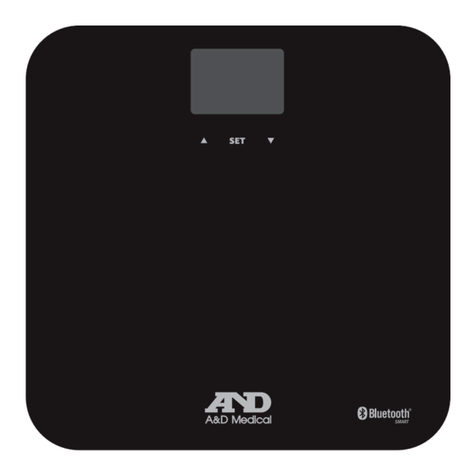
AND
AND PLUS CONNECT UC-350BLE User manual
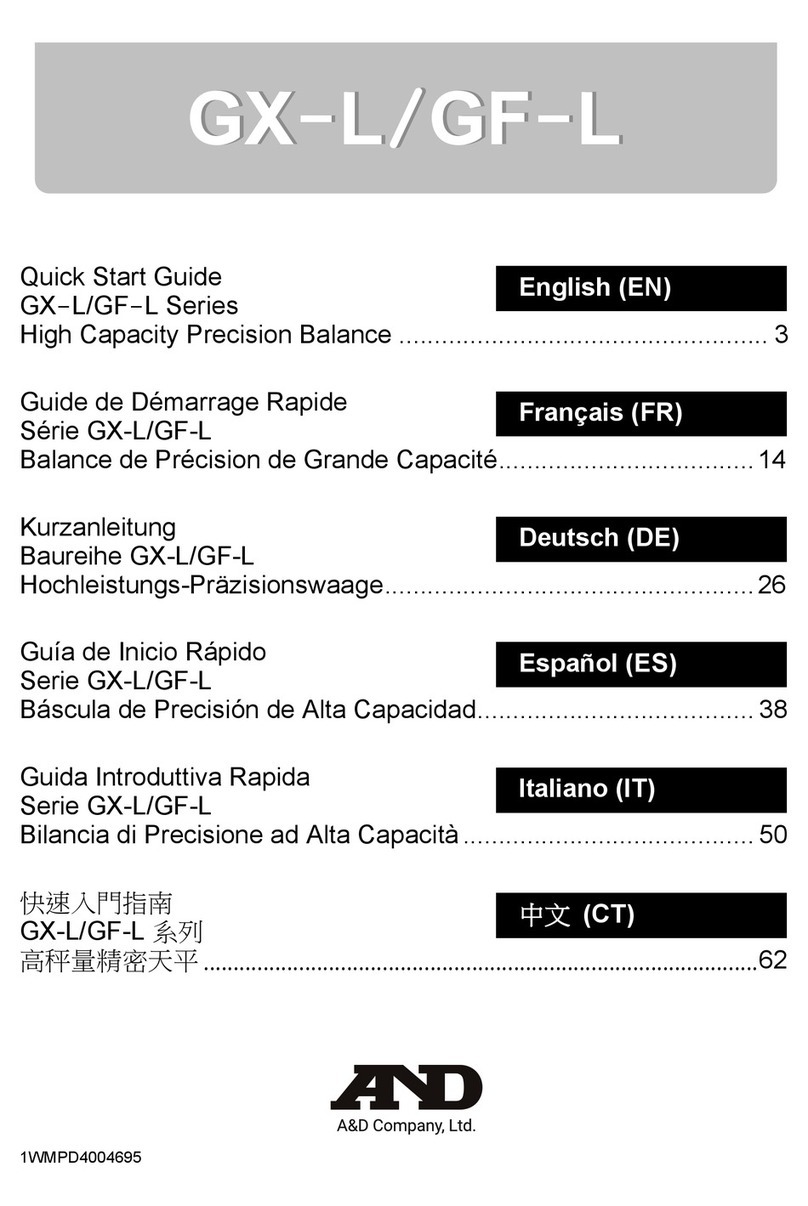
AND
AND GX-L Series User manual
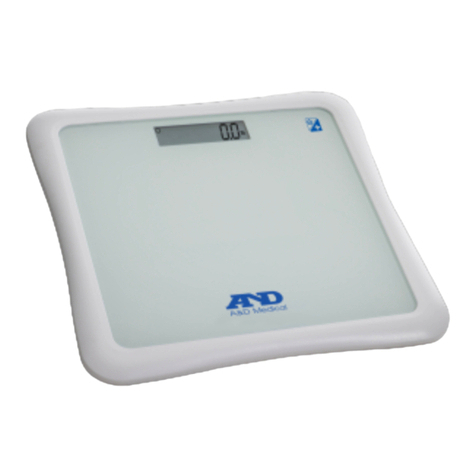
AND
AND UC-324ANT User manual
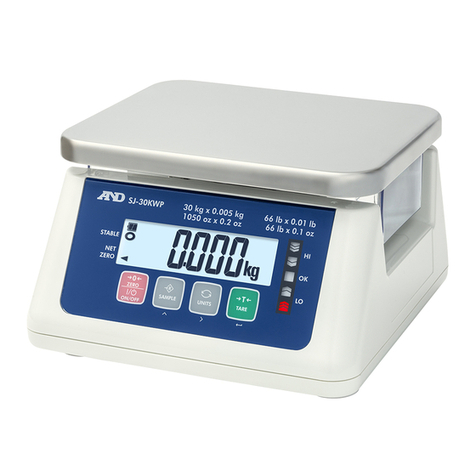
AND
AND SJ-3000WP/-BT User manual
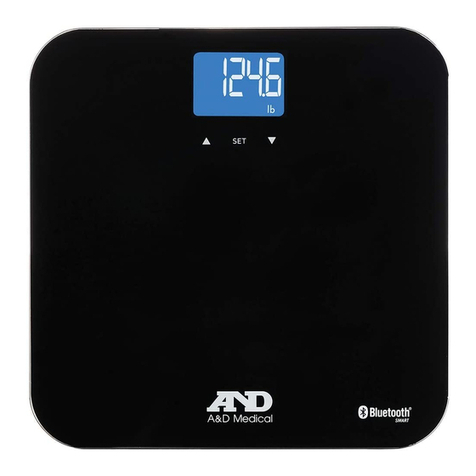
AND
AND PLUSCONNECT UC-350CNBLE User manual
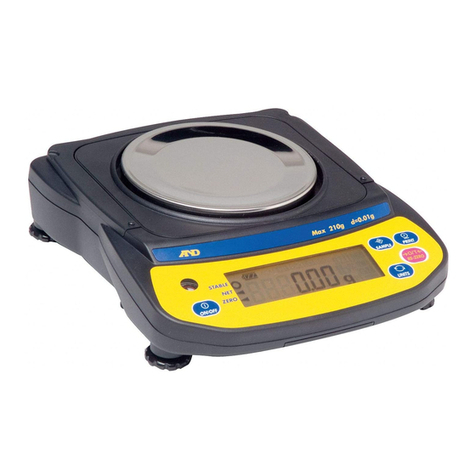
AND
AND EJ-120 User manual
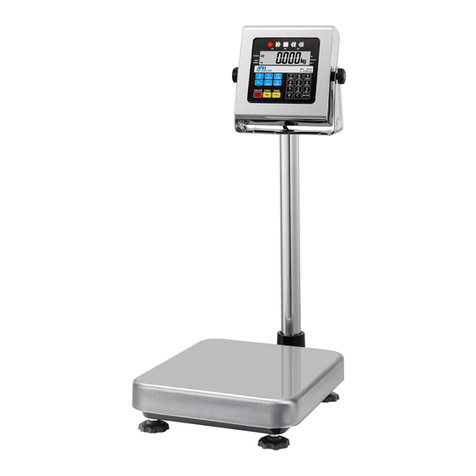
AND
AND HV-CWP Series User manual
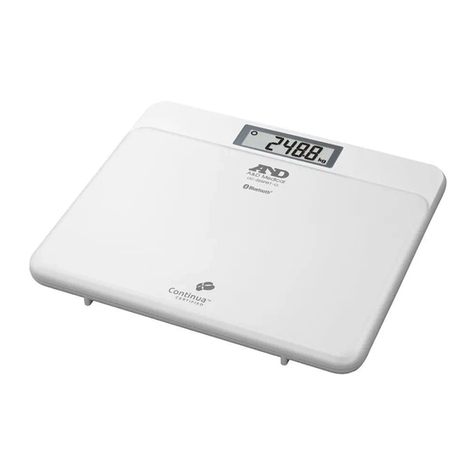
AND
AND UC-355PBT-Ci User manual
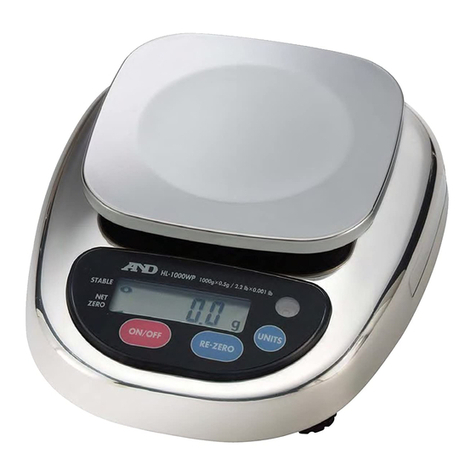
AND
AND HL-WP Series User manual
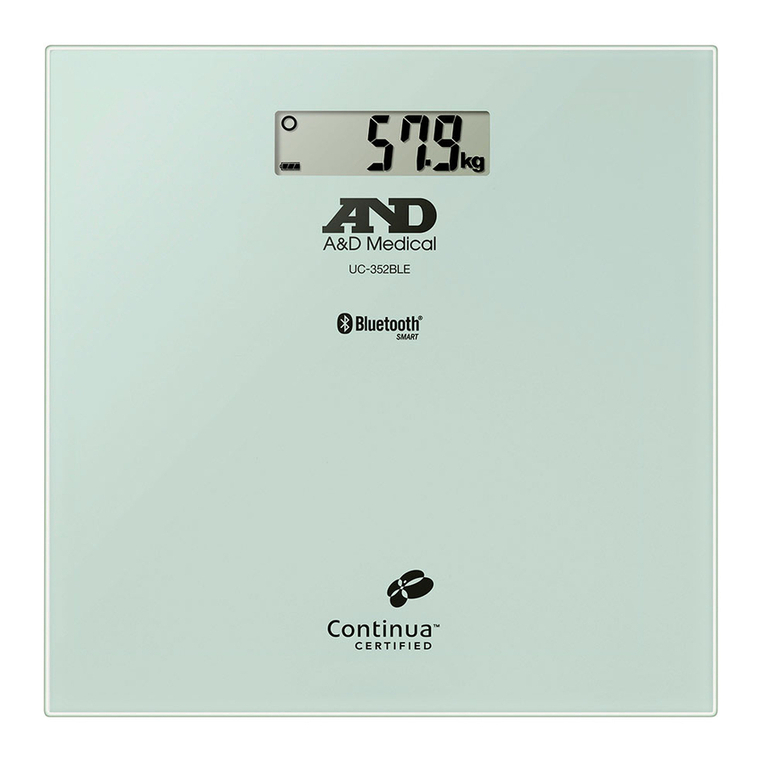
AND
AND UC-352BLE User manual
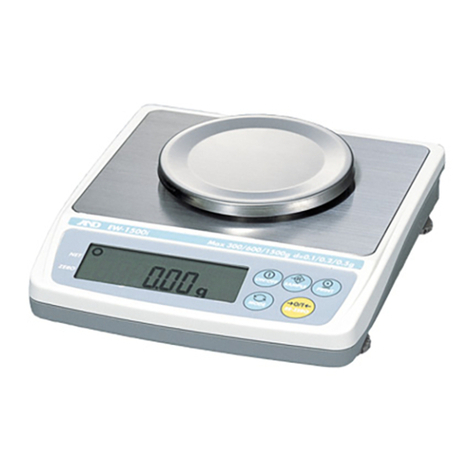
AND
AND EK-610j User manual

AND
AND HL-200i User manual
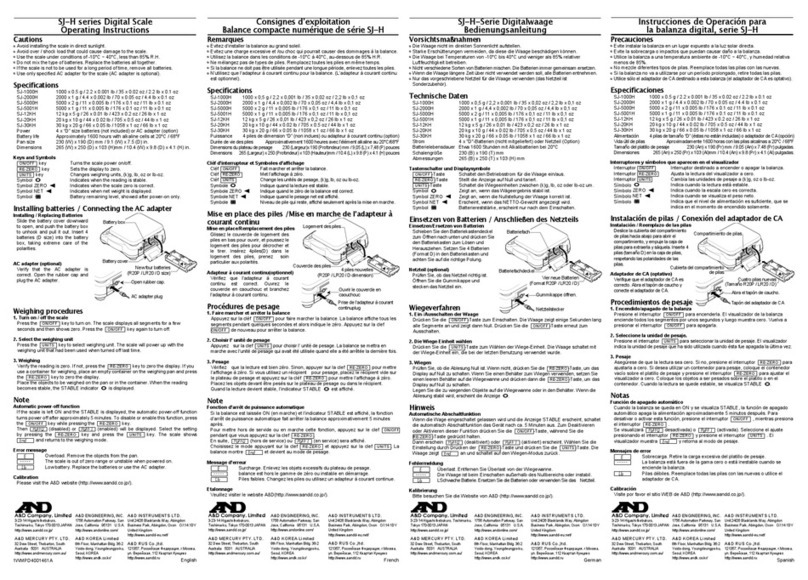
AND
AND SJ-2000H User manual
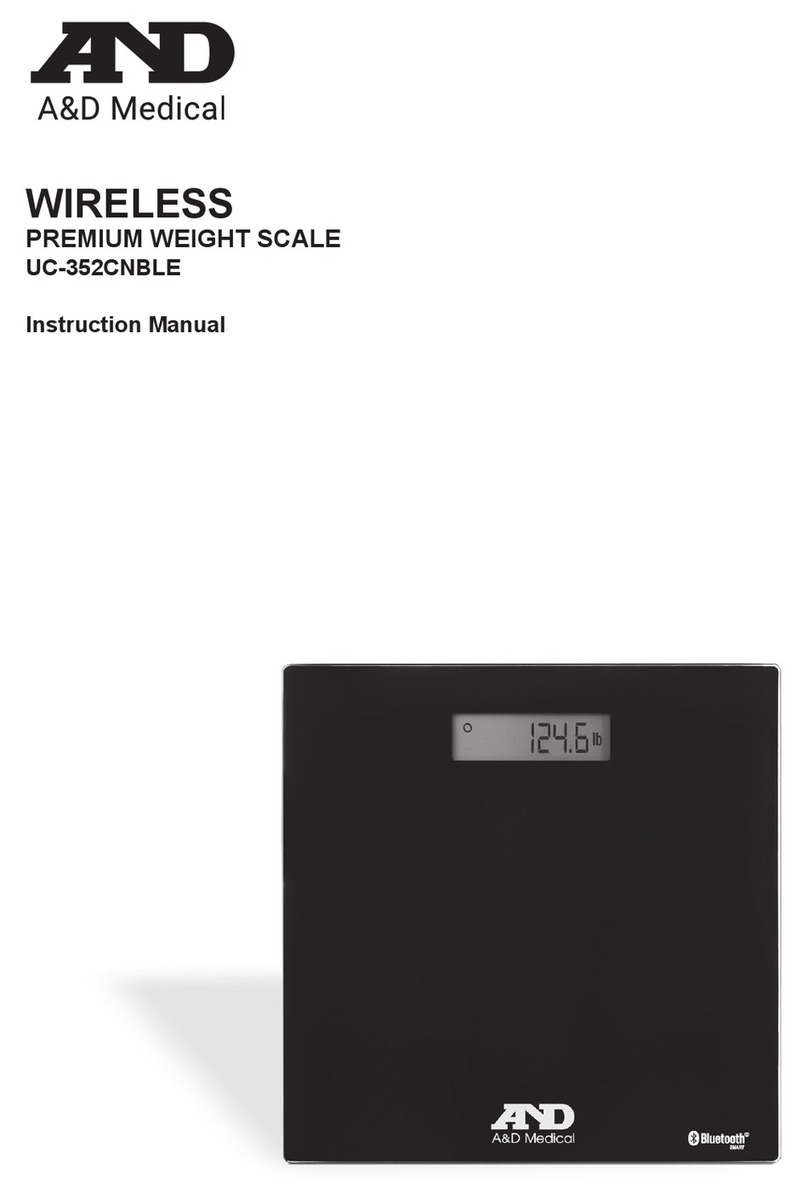
AND
AND PREMIUM UC-352CNBLE User manual
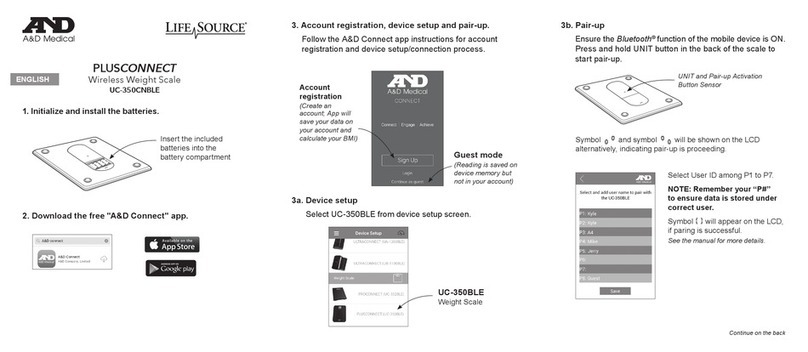
AND
AND LifeSource UC-350CNBLE User manual
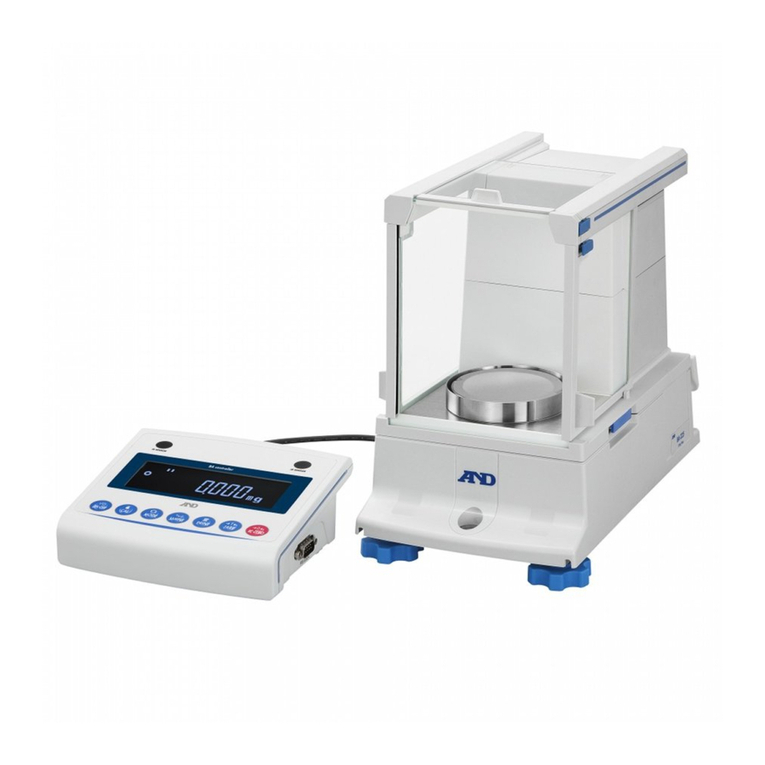
AND
AND BA-TE Series User manual
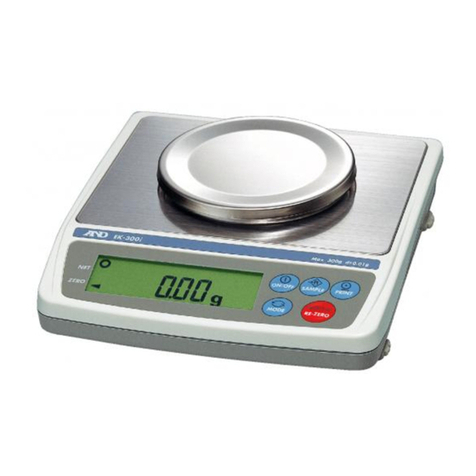
AND
AND EK-ilEW-i Series User manual

AND
AND SK-1000WP User manual
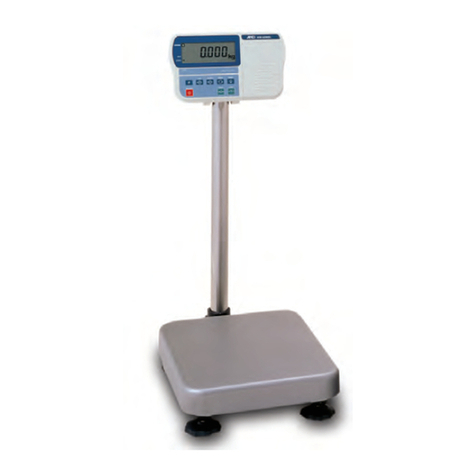
AND
AND HV-15KGL User manual
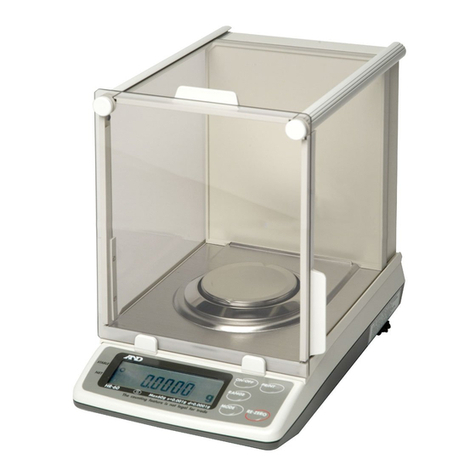
AND
AND HR Series User manual
